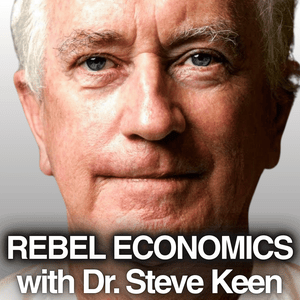“The real problem isn't deficits, It's Neoliberalism“ Top Economist warns
Learn 50+ Years of Economics in Only 7 Weeks, by applying here: https://www.stevekeen.comThis video is an extended version of previous video - "Deficits aren't the danger to the US, THIS is..." Top Economist warns(Plus get Ravel — the economic visualization software used in this video — as a bonus if you’re accepted and join.)Economist Steve Keen explains how decades of neoliberal U.S. policies have turned government deficits into a dangerous economic cycle. Using clear double-entry accounting and Ravel visualizations, Steve reveals how the obsession with balanced budgets and market deregulation has weakened the real economy, inflated private debt, and set the stage for financial collapse.He breaks down how bank lending still creates most of the money in circulation, why government deficits actually build deposits and reserves, and how open-market operations merely reshuffle assets instead of generating real wealth. Finally, Steve proposes a Modern Debt Jubilee — a practical path to reset the system, reduce unpayable private debts, and restore long-term financial stability without falling into the illusion of “printing money.”In this breakdown, you’ll discover:✅ Cash vs digital money: why the press in DC is a sideshow✅ Government spending and taxes in the ledger: deposits up, taxes down — what really changes✅ Reserves 101: what banks can and can’t do with them (and why they aren’t “spendable” money)✅ Deficit mechanics: why deficits create both money and reserves, surpluses destroy them✅ The eight entries you need to model government money creation (beyond simple double entry)✅ Why “borrowed from the private sector” is an accounting myth in loanable-funds models✅ How OMOs and QE actually work: when they create money, when they don’t✅ The data picture: since 2000, most new money has been credit-backed (private), not fiscal✅ Why government negative financial equity is normal — and necessary for private net financial assetsKey insights:• Deficit is not a bug — it’s the feature that creates net financial assets for the private sector.• Reserves are bank-to-central-bank balances; they support payments and bond settlement, not your latte.• Open-market operations with non-banks can create money; purchases from banks swap assets inside the banking system.• Loanable-funds thinking explodes government debt in theory because it excludes money creation in the first place.• Accounting done properly shows government negative financial equity mirrors private positive equity.-----What did you think of the eight-entry walkthrough and the OMO/QE distinctions? Share your thoughts below.Subscribe for reality-based economicsLike if this clarified how deficits, reserves, and QE actually workShare to help others move beyond textbook myths-----Who is Dr. Steve Keen?Dr. Steve Keen is an economist known for accounting-consistent, data-driven models that explain how bank money, private debt, and policy operations shape the real economy. Creator of the Minsky and Ravel tools, he replaces classroom analogies with operational mechanics — essential for engineers, finance professionals, and anyone who wants clarity over ideology.Learn 50+ Years of Economics in Only 7 Weeks, by applying here: https://www.stevekeen.com(Plus get Ravel — the software used in this video — as a bonus if you’re accepted and join.)#usshutdown #usdebtcrisis #useconomy #usdebt #BankingSystem #QE #economics #money #Macroeconomics #usgovernment


